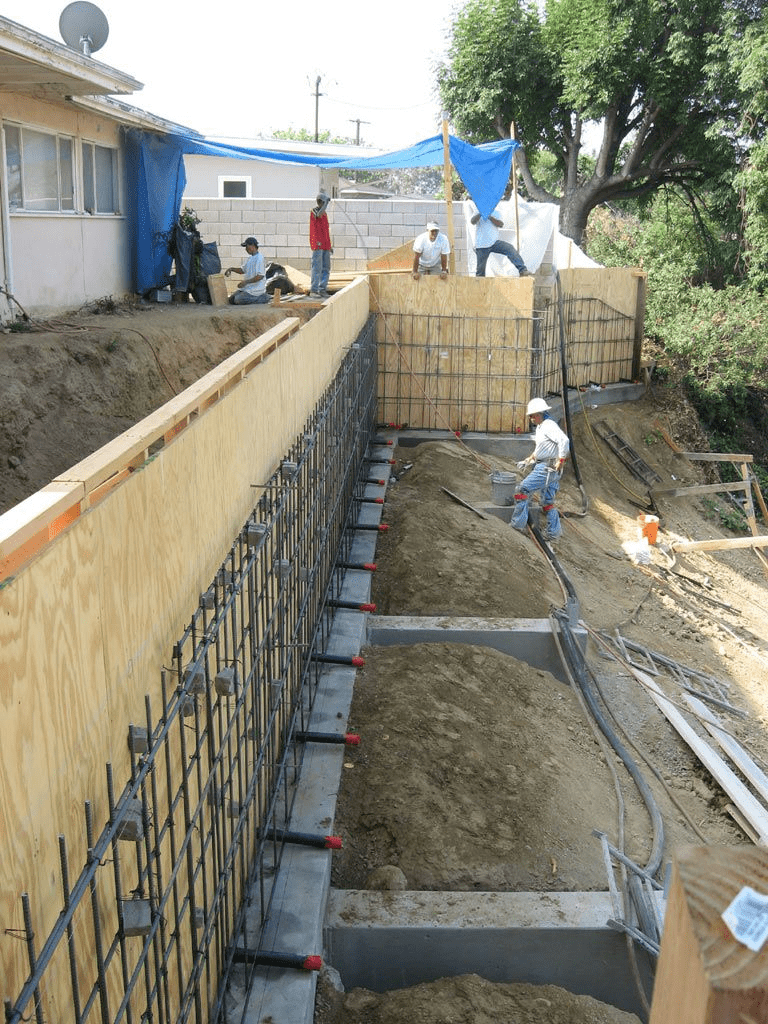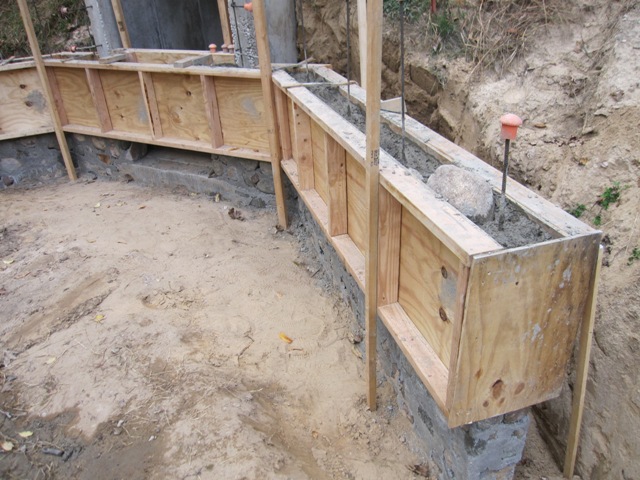Building a concrete wall is not rocket science. Reserving walls are made of low cost, high strength concrete. The process to build it is pretty simple. However, there are several important things to consider to ensure you get the best possible results.
How to build a concrete retaining wall form How to build a concrete retaining wall on a slope – In this article, I’ll go over the important things you should know about building a concrete retaining wall form. If this is your first time building a retaining wall, it can be a little tricky at first. But with some planning and preparation, you’ll have it done in no time!

How to build a concrete retaining wall
How to Build a Concrete Retaining Wall. A retaining wall is a structure designed to support the Earth around it. There are many different types of retaining walls, but most are used for landscaping purposes. To build a concrete retaining wall, you will need to use forms to create the shape of the wall, then pour concrete into the form and allow it to dry. Once your retaining wall is completed, you can use mortar to cover any areas where the concrete meets other surfaces or materials.
Build Your Concrete Retaining Wall Forms
The first step in building a concrete retaining wall is creating the forms that will shape your structure. You can create your own form using wood or metal, or purchase pre-made forms from a home improvement store. The size and complexity of your form will depend on how large your retaining wall will be and what type of terrain you are building on. When selecting wood for your forms, choose pressure treated lumber because it does not rot easily when exposed to moisture. To make sure your form stays in place during construction, place stakes at each corner so they do not move when you pour concrete into them
Concrete retaining walls are often used to hold back earth or rock, and they can be built in a variety of shapes. A concrete retaining wall can be built using many different methods depending on the shape and size of the wall, its location and what it will be used for.
Concrete is a very strong material and will not rot or decay over time, so it makes an excellent choice for building a retaining wall. However, this strength also makes it very heavy and difficultwork with.

If you are building your own concrete retaining wall, there are several steps involved:
Excavate the area where you will be placing the wall. Remove all dirt from within 1 foot of where the bottom of your wall will be located. Dig down at least 6 inches below ground level at this point to allow for drainage. This means digging down deeper than where you plan on pouring your concrete mix into forms because it will settle after being poured into forms. If your ground is rocky or contains large stones that cannot be removed easily with hand tools such as shovels and pick axes, consider renting an auger attachment for your power drill; these attachments have long metal shafts that are used to drill through hard ground without damaging them like regular drill bits do
Concrete retaining walls are a great way to add curb appeal to your home, add space and value to your property, or make room for a swimming pool. If you’re ready to build a concrete retaining wall, follow these steps:
Choose the right design. There are several different designs for concrete retaining walls. The simplest is an L-shaped wall that contains soil on one side and sits against the house or another structure on the other side. This type of wall is usually only about 6 inches tall at its highest point, so it’s suitable for small areas such as flower beds or gardens. If you’re planning on building a larger retaining wall (more than 8 feet tall), you’ll need more complex engineering and design work done beforehand by an engineer or architect who specializes in concrete construction.
Prepare your site. Make sure the ground beneath where you plan to place your retaining wall has enough space for future expansion and maintenance needs; this includes access points for electrical lines and plumbing pipes that run under the ground surface near your house. Also check that there aren’t any underground utility lines running under your site — if there are, contact whoever owns them before proceeding with construction

Building a concrete retaining wall is a great way to add structure and function to your landscape. A retaining wall is an essential element of any property that can help you create more usable space, improve the look of your lawn, and provide safety for children and pets.
If you’re ready to build your own concrete wall, follow these steps:
Step 1: Prepare Your Site
Before you begin building, make sure that the area where you want to construct the wall is prepared properly. Clear all debris from the area where the wall will be installed and level any uneven ground with sand or soil. This process will help ensure that your wall will remain strong and stable throughout its lifetime.
There are two ways to build a retaining wall: on a flat, level surface and on a slope. The method you choose depends on the situation and the topography of your yard.
If you’re building your wall on level ground, you can use either concrete blocks or poured concrete. If you’re building it on a slope, however, it’s best to use poured concrete because it can be built in sections that fit together like puzzle pieces.
Concrete blocks are heavy and difficult to handle. They require more work than poured concrete and may not be appropriate for slopes of more than 30 degrees.
Concrete retaining walls are the most common type of wall used to hold back soil from sloping land. A concrete retaining wall is a great way to improve your home’s appearance and increase its value. The materials needed to build a concrete retaining wall don’t cost too much, and you can use them to create an attractive garden or landscape feature that will last for years.
Step 1: Install Your Concrete Forms
Installing your forms for the first course of concrete is usually the most difficult part of the project. You’ll need to make sure that they are set up in the correct position and level, so that when you pour your first layer of concrete it will be straight and level with the ground below it.
Step 2: Pour Your First Course of Concrete
After you’ve installed your forms, it’s time to pour your first layer of concrete into them. This will form the base for your new wall, so make sure it’s strong enough to support itself and any other materials that may be placed on top of it in future courses. You should also make sure that the edges of each form are completely filled with concrete; any gaps between the edge and form could allow water into the wall later on, which may cause cracks or other problems
Step 1: Set up your form.
The most common type of concrete retaining wall is made with interlocking blocks that are laid flat against the soil. The wall itself consists of several lengths of rebar, which you’ll use to reinforce the blocks and hold them together. First, set up your form by driving stakes into the ground every 6 feet or so along the length of your wall. Then tie string between each stake to create an outline for your form. You can make these strings out of twine or rope, or use plastic garden hose if you have it lying around.
Step 2: Lay out your first course of blocks.
The first course will be the base for everything else, so make sure it’s level and straight before you start adding extra layers. Begin by placing a block on each string at each stake location; use a level to make sure they’re plumb (that is, perpendicular). Then check them again after you’ve laid out all four sides of this course; if any are off-kilter, pull them out and reset them until they’re level and plumb again.
Step 3: Add a second layer of blocks.
Once again, begin by placing a block on each string at each stake location; this time

A concrete retaining wall is one of the most popular DIY projects. It’s easy to construct and can be built to virtually any size or shape. The key is to follow these tips for building a concrete retaining wall:
Measure the length, width and height of your project area (length is usually determined by your budget). Then decide how much slope you want for each level of your retaining wall. For example, if you’re building a straight wall with no slope, you’ll need a single row of blocks. If you want a sloped wall with two levels, you’ll need three rows of blocks.
Dig out the area where your footing will go using a post hole digger or shovel. Make sure the footing depth is at least twice as deep as the thickness of your block (4 inches deep for 2-inch-thick blocks). Also make sure there are no large rocks or roots obstructing your dig site. Level off the bottom of each footing with sandbags or small stones if necessary before backfilling it with compacted gravel or soil mix (for non-sloped walls) or compacted earth (for sloped
The best way to build a concrete retaining wall is to use a form. This gives you a more uniform shape and ensures that you don’t end up with large gaps between the blocks.
There are two main types of forms:
A temporary form, which is built off the ground and removed after the concrete has set, or
A permanent form, which is built into the ground and remains in place.
The type of form you choose will depend on the size and complexity of your wall. For small walls that are less than 1m high, a temporary form is usually enough. For larger walls or walls that have curves or angles in them, however, it’s better to use a permanent form.
A retaining wall is a structure built to resist the lateral pressure of soil. A retaining wall can be made from many different materials, but most are constructed of either concrete or masonry.
Many types of retaining walls have been developed, but by far the most common design is a gravity wall. The simplest form of gravity wall is a gravity block wall, which consists of blocks stacked in layers with each layer resting on the one below it. This type of wall relies on the weight of the blocks to hold back the earth behind it.
Gravity walls can be built directly on top of loose earth or over compacted fill material such as gravel or stone chips. They can also be built off-site and set into place at a later date.
A cantilever retaining wall is another simple form of gravity block wall that uses cantilevered arms instead of vertical supports to bridge larger gaps between rows of blocks. Cantilever arms are typically made from steel rods or I-beams with their ends anchored into bedrock at either end; however, some manufacturers offer precast concrete versions as well.
